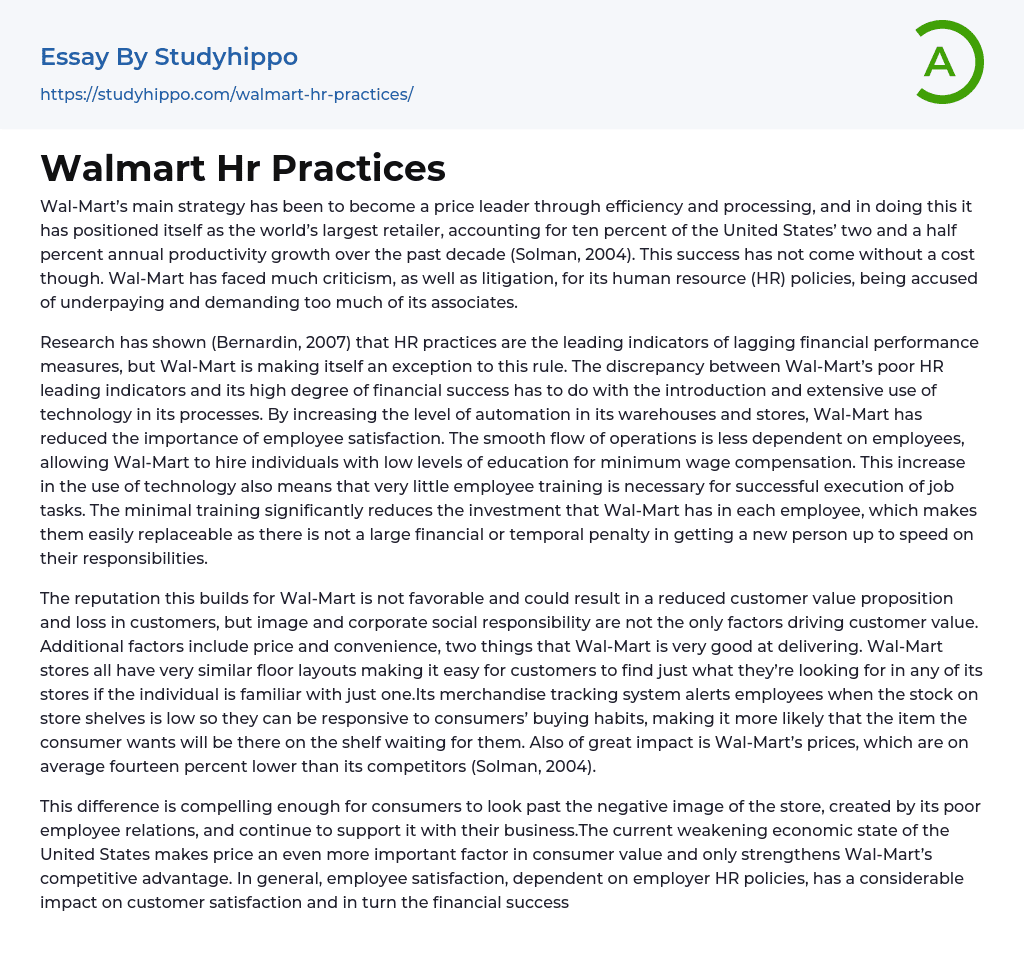Wal-Mart’s main strategy has been to become a price leader through efficiency and processing, and in doing this it has positioned itself as the world’s largest retailer, accounting for ten percent of the United States’ two and a half percent annual productivity growth over the past decade (Solman, 2004). This success has not come without a cost though. Wal-Mart has faced much criticism, as well as litigation, for its human resource (HR) policies, being accused of underpaying and demanding too much of its associates.
Research has shown (Bernardin, 2007) that HR practices are the leading indicators of lagging financial performance measures, but Wal-Mart is making itself an exception to this rule. The discrepancy between Wal-Mart’s poor HR leading indicators and its high degree of financial success has to do with the introduction and extensive use of technology in its pro
...cesses. By increasing the level of automation in its warehouses and stores, Wal-Mart has reduced the importance of employee satisfaction. The smooth flow of operations is less dependent on employees, allowing Wal-Mart to hire individuals with low levels of education for minimum wage compensation. This increase in the use of technology also means that very little employee training is necessary for successful execution of job tasks. The minimal training significantly reduces the investment that Wal-Mart has in each employee, which makes them easily replaceable as there is not a large financial or temporal penalty in getting a new person up to speed on their responsibilities.
The reputation this builds for Wal-Mart is not favorable and could result in a reduced customer value proposition and loss in customers, but image and corporate social responsibility are not the only factors
driving customer value. Additional factors include price and convenience, two things that Wal-Mart is very good at delivering. Wal-Mart stores all have very similar floor layouts making it easy for customers to find just what they’re looking for in any of its stores if the individual is familiar with just one.Its merchandise tracking system alerts employees when the stock on store shelves is low so they can be responsive to consumers’ buying habits, making it more likely that the item the consumer wants will be there on the shelf waiting for them. Also of great impact is Wal-Mart’s prices, which are on average fourteen percent lower than its competitors (Solman, 2004).
This difference is compelling enough for consumers to look past the negative image of the store, created by its poor employee relations, and continue to support it with their business.The current weakening economic state of the United States makes price an even more important factor in consumer value and only strengthens Wal-Mart’s competitive advantage. In general, employee satisfaction, dependent on employer HR policies, has a considerable impact on customer satisfaction and in turn the financial success of a corporation, but in Wal-Mart’s case, it is not so. Wal-Mart has distinguished itself as a price leader and its success in doing this has created customer value that outweighs dissatisfied employees and their impact on customers.
Wal-Mart has worked to minimize the potential negative impact that its discontented employees can have on customers by increasing its use of technology in the day-to-day activities once performed by its employees and by making its associate positions easily filled. This reduces the need for favorably-viewed HR policies, as if an employee
does not perform up to the standards specified in their job requirements, they can be replaced with minimal impact on the company. While the disconnect between Wal-Mart’s HR policies and financial performance measures is very real today, this may not continue to be the case in the future.An improvement in the United States’ economy could reduce the weight that low prices carry in consumer decision making processes, bringing Wal-Mart’s HR policies to the forefront and resulting in a negative impact on its financial performance measures.
References
- Bernardin, H. J. (2007). Human Resource Management 4th edition. Boston: McGraw-Hill Irwin. Solman, P. (2004, Aug. 20). [Television broadcast] The NewsHour with Jim Lehrer. [Transcript] Retrieved Jan.25, 2008, from http://www. pbs. org/newshour/bb/business/july-dec04/wal-mart_8-20. html
- Auction essays
- Balanced Scorecard essays
- Business Plans essays
- Expense essays
- Income essays
- Net Income essays
- Security Guard essays
- Singapore Airlines essays
- Battle essays
- Intranet essays
- Maintenance essays
- Simulation essays
- Inn essays
- Chief Executive Officer essays
- Convenience Store essays
- Firm essays
- Training And Development essays
- Unilever essays
- Variable Cost essays
- Virgin Group essays
- Bargaining essays
- Entity essays
- Pest analysis essays
- Qualities essays
- Leadership and Management essays
- Change Management essays
- Project Management essays
- Knowledge Management essays
- Operations Management essays
- Quality Management essays
- Risk Management essays
- Scientific Management essays
- supply chain management essays
- Performance Management essays
- Time Management essays
- Brand Management essays
- Total Quality Management essays
- Risk essays
- Manager essays
- Leadership essays
- Business Ethics essays
- Board Of Directors essays
- Product Management essays
- Comparative Analysis essays
- Decision Making essays
- Dispute Resolution essays
- Stress Management essays
- Business Management essays
- Brand Equity essays
- Branding essays




